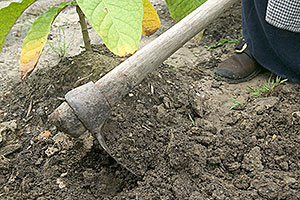Page content
Historic Farming
Agriculture and the War
Beyond the political upheaval of the Revolutionary War, the war years brought often sudden and profound changes to Virginia’s rural plantations and farmsteads. These were felt in economic and social terms that have been well revealed in the work of Lorena Walsh. In her unpublished work on plantation management, Lorena offers an overview of the impact of war on Chesapeake society.
The following excerpts from Chapter 5, The Best and the Worst of Times, 1764-1789 illustrate this more clearly:
Between 1774 and 1781, Chesapeake planters had no way of predicting the eventual outcome of the struggle in which they were engaged. Families had to shape their responses to the immediate course of events. Optimism alternated with pessimism; individual sacrifice in public service with unrestrained private greed. At times strategies for long-term family survival predominated, but sometimes a chance to make fast money proved irresistible, however questionable the means.
The war brought material hardships to all classes, black and white. Shortages of corn, cloth, shoes, salt, and medicines caused the rich inconvenience while the poor and enslaved shivered and went hungry. Only families who lived on the Eastern Shore where there were more secure overland and coastal routes north were sure enough of being able to market crops that they maintained anything close to pre-war levels of farm production. Throughout most of the tidewater, where farmers depended on more exposed water routes to carry bulky produce to distant markets — most now cut off by the war — production of tobacco and grains dropped dramatically. Planters received scant revenues because they produced few surplus crops, and they planted little surplus of anything because they could not be sure of selling it. “What agriculturalist put money into his pocket for these years or did more than round his expenditures by his products?” one planter asked. A number of large Virginia planters estimated their losses between 1774 and 1782 from “deprivation of crops, and want of a market for the little that was raised” at L10,000 sterling.
Other losses were more easily assessed. First, British raiders destroyed crops, livestock, and buildings. Second, in Virginia alone some 30,000 slaves fled to the enemy, and there were few large tidewater planters who did not lose some of their chattels. Third, wherever present in any number, troops spread smallpox, dysentery, and camp fever to the civilian population, causing additional losses, and forcing planters for the first time to pay for mass smallpox inoculations among their slaves. Fourth, in some areas herds of cattle and horse had probably been depleted in order to provide provision and transport for the army, and in others, timber over cut to supply towns and troops with firewood. Finally, everywhere farm buildings deteriorated. With the future so uncertain and crop production curtailed, planters chose not to repair houses, barns, and fences. When the war was finally won, there was a great deal of catching up to do.
An unprecedented amount of absenteeism also contributed to decline. Before the war few planters stayed away from home for long. As the crisis with the mother country deepened, service on local committees of correspondence and safety, in state government, in the Continental Congress, in the continental army or the state militias, and finally at the Constitutional Convention and subsequent state ratifying conventions kept a high proportion of more substantial planters away from their farms for long periods, sometimes for several years at a time. Losses among ordinary families whose men were away in the army were probably higher in proportion to the size of their estates. Farms left to the total care of wives, overseers, or general managers suffered, while slaves, probably less closely supervised than usual, found more chances to work less diligently and more opportunities for running off.
But often the hardships were unevenly shared. Those who risked most by taking a prominent role in the rebellion, as well as those who too openly backed the British, lost more by absence (or in the latter case, punitive taxation or outright confiscation) than did those who avoided extreme positions and sat out the war on their farms. Men on the spot were in a better position to salvage something, often by speculation. Sons of the rich, should they be drafted for service in the militia, could count on their relatives coming up with money for a substitute if they did not want to fight, while poor boys could not. Those who refused to accept continental or state paper monies in payment of rents and debts came out well ahead of those who felt honor-bound to support the cause by accepting these monies. Finally, farmers who lived on the eastern shore or near towns had better chances to sell crops or to get hold of imports than did more isolated families.
These generalizations are largely drawn from the experiences of families at the very top. Studies of the war-time fortunes of small planters and tenants are as yet too few and scattered to permit broad generalizations. [Jackson T.] Main’s analysis of Virginia tax records for 1782 and 1783 suggest that many tenants and small farmers fared badly after the war, while four local studies suggest similar distress among poor whites in Maryland. During the period 1764-1789 Chesapeake planters experienced times both of unprecedented prosperity and of unprecedented hardship. Independence was purchased at a high price and, if the planters surveyed in this and the preceding chapter are in any way representative, by the end of the war losers appear to have greatly outnumbered gainers. Consequently recovery was slow.

